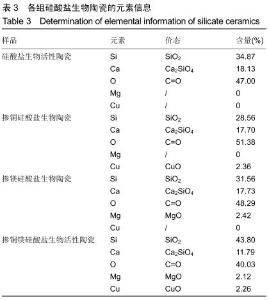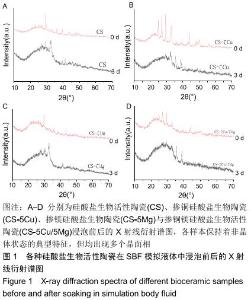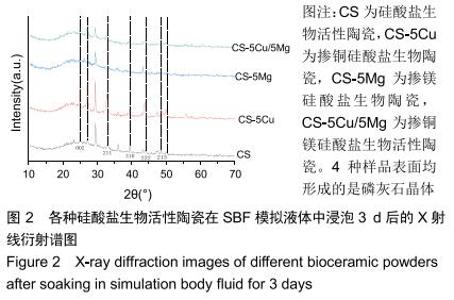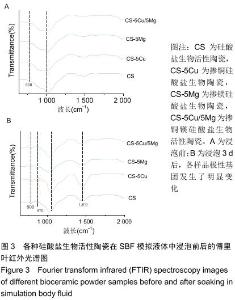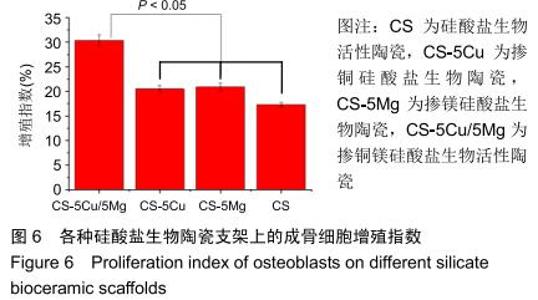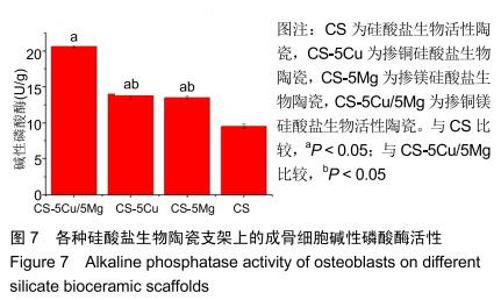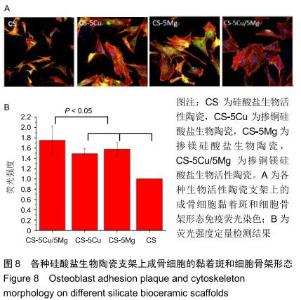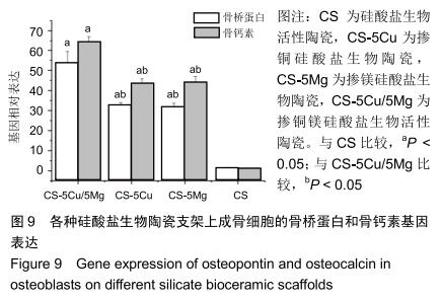|
[1] WENG L, BODA SK, TEUSINK MJ, et al. Binary Doping of Strontium and Copper Enhancing Osteogenesis and Angiogenesis of Bioactive Glass Nanofibers while Suppressing Osteoclast Activity.ACS Appl Mater Interfaces. 2017;9(29): 24484-24496.
[2] ROGERS GF, GREENE AK. Autogenous bone graft: basic science and clinical implications.J Craniofac Surg. 2012;23(1): 323-327.
[3] KIERNAN CH, WOLVIUS EB, BRAMAPAJ, et al. The Immune Response to Allogeneic Differentiated Mesenchymal Stem Cells in the Context of Bone Tissue Engineering.Tissue Eng Part B Rev. 2018;24(1):75-83.
[4] KIM HD, AMIRTHALINGAM S, KIM SL, et al. Biomimetic Materials and Fabrication Approaches for Bone Tissue Engineering.Adv Healthc Mater. 2017;6(23). doi:10.1002/adhm.201700612.
[5] NOORI A, ASHRAFI SJ, VAEZ-GHAEMI R, et al. A review of fibrin and fibrin composites for bone tissue engineering.Int J Nanomedicine.2017;12:4937-4961.
[6] BAINO F, POTESTIO I, VITALE-BROVARONE C, et al. Production and Physicochemical Characterization of Cu-Doped Silicate Bioceramic Scaffolds.Materials(Basel). 2018;11(9):1524.
[7] LEU A, LEACH JK. Proangiogenic potential of a collagen/ bioactive glass substrate.Pharm Res. 2008;25(5):1222-1229.
[8] LEU A, STIEGER SM, DAYTON P, et al. Angiogenic response to bioactive glass promotes bone healing in an irradiated calvarial defect.Tissue Eng Part A.2009;15(4):877-885.
[9] DAY RM. Bioactive glass stimulates the secretion of angiogenic growth factors and angiogenesis in vitro.Tissue Eng.2005;11(5-6): 768-777.
[10] SHI F, LIU Y, ZHI W, et al. The synergistic effect of micro/nano-structured and Cu2+-doped hydroxyapatite particles to promote osteoblast viability and antibacterial activity. Biomed Mater.2017;6;12(3):035006.
[11] REN L, WONG HM, YAN CH, et al. Osteogenic ability of Cu-bearing stainless steel.J Biomed Mater Res B Appl Biomater. 2015;103(7):1433-1444.
[12] HU K, OLSEN BR. Osteoblast-derived VEGF regulates osteoblast differentiation and bone formation during bone repair.J Clin Invest. 2016;126(2):509-526.
[13] PRADO FERRAZ E, PEREIRA FREITAS G, CAMURI CROVACE M, et al. Bioactive-glass ceramic with two crystalline phases (BioS-2P) for bone tissue engineering. Biomed Mater.2017;12(4): 045018.
[14] THOMAS A, ERA J. Preparation and characterization of gelatin-bioactive glass ceramic scaffolds for bone tissue engineering. J Biomater Sci Polym Ed.2019;30(7):561-579.
[15] NIKPOUR P, SALIMI-KENARI H, FAHIMIPOUR F, et al. Dextran hydrogels incorporated with bioactive glass-ceramic: Nanocomposite scaffolds for bonetissue engineering. Carbohydr Polym.2018;15;190:281-294.
[16] FENG Y, LI Q, WU D, et al A macrophage-activating, injectable hydrogel to sequester endogenous growth factors for in situ angiogenesis.Biomaterials.2017;134:128-142.
[17] VANHATUPA S, MIETTINEN S, PENA P, et al. Diopside-tricalcium phosphate bioactive ceramics for osteogenic differentiation of human adipose stem cells.J Biomed Mater Res B Appl Biomater. 2019;108(3):819-833.
[18] DENG C, CHANG J, WU CT, et al. Bioactive scaffolds for osteochondral regeneration.J Orthop Translat.2018;26;17:15-25.
[19] MANTOVANI A, LOCATI M. Macrophage Metabolism Shapes Angiogenesis in Tumors.Cell Metab. 2016;24(6):887-888.
[20] RAU JV, CURCIO M, RAUCCI MG, et al. Cu-Releasing Bioactive Glass Coatings and Their in Vitro Properties.ACS Appl Mater Interfaces.2019;13;11(6):5812-5820.
[21] HELLBERG C, OSTMAN A, HELDIN CH, et al. PDGF and vessel maturation.Recent Results Cancer Res. 2010;180:103-114.
[22] MILKOVIC L, HOPPE A, RAUCCI MG, et al. Effects of Cu-doped 45S5 bioactive glass on the lipid peroxidation-associated growth of human osteoblast-like cells in vitro.J Biomed Mater Res A. 2014;102(10):3556-3561.
[23] TAMPIERI A, RUFFINI A, BALLARDINI A, et al. Heterogeneous chemistry in the 3-D state: an original approach to generate bioactive, mechanically-competent bone scaffolds.Biomater Sci. 2018;18;7(1):307-321.
[24] VARADINOVA TL, ZLATEVA KT, DYULGEROVAEI, et al. Cell response to herpes simplex virus type 1 infection mediated by biphasic calcium-phosphateceramics: in vitro approach.J Biomed Mater Res.2001;57(2):232-237.
[25] ROMAN J, SALINAS AJ, VALLET-REGIM, et al. Role of acid attack in the in vitro bioactivity of a glass-ceramic of the 3CaO. P2O5-CaO.SiO2-CaO.MgO.2SiO2 system. Biomaterials.2001; 22(14):2013-2019.
[26] KOKUBO T, KUSHITANI H, SAKKA S, et al. Solutions able to reproduce in vivo surface-structure changes in bioactive glass-ceramic A-W.J Biomed Mater Res.1990;24(6):721-734.
[27] LI H, XUE K, KONG N, et al. Silicate bioceramics enhanced vascularization and osteogenesis through stimulating interactions between endothelia cells and bone marrow stromal cells. Biomaterials. 2014;35(12):3803-3818.
[28] CAVEDA L, MARTIN-PADURA I, NAVARRO P, et al. Inhibition of cultured cell growth by vascular endothelial cadherin (cadherin-5/VE-cadherin).J Clin Invest.1996;98(4):886-893.
[29] CHING HS, LUDDIN N, RAHMAN IA, et al. Expression of Odontogenic and Osteogenic Markers in DPSCs and SHED: A Review.Curr Stem Cell Res Ther.2017;12(1):71-79.
[30] MA J, WANG Z, ZHAO J. Resveratrol Attenuates Lipopolysaccharides (LPS)-Induced Inhibition of Osteoblast Differentiation in MC3T3-E1 Cells.Med Sci Monit. 2018;24: 2045-2052.
[31] YIN C, ZHANG Y, CAI Q, et al. Effects of the micro-nano surface topography of titanium alloy on the biological responses ofosteoblast.J Biomed Mater Res A.2017;105(3):757-769.
[32] PONTE AL, MARAIS E, GALLAY N, et al. The in vitro migration capacity of human bone marrow mesenchymal stem cells: comparison of chemokine and growth factor chemotactic activities. Stem Cells.2007;25(7):1737-1745.
[33] STRATMAN AN, SCHWINDT AE, MALOTTE KM, et al. Endothelial-derived PDGF-BB and HB-EGF coordinately regulate pericyte recruitment during vasculogenic tube assembly and stabilization.Blood.2010;116(22):4720-4730.
|
